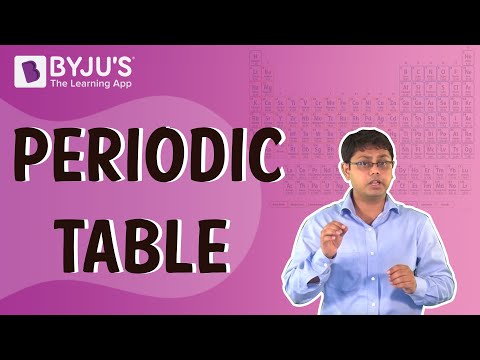Dmitri Mendeleev proposed the periodic table. He arranged elements in order of their atomic number. It enables him to place the elements in specific rows and columns. The rows were named as periods, and columns were named as groups. It contains seven rows and eighteen columns.
|
Definition: Periodic Table is an organised collection of elements in order of increasing atomic number. When atoms are arranged in this pattern, elements in the same group have similar properties. |
Periodic Table Chemistry Questions with Solutions
Q1. Which of the following element has a zero valency?
- Chlorine
- Helium
- Caesium
- Livermorium
Answer: (b) Helium has a zero valency.
Q2. While moving down in a group, the metallic character …………..
- Increases
- Decreases
- Remains constant
- First increases than decreases.
Answer: (a) Increases.
Explanation: As we move down the group, the number of shells increases, and thus losing electrons becomes easy for an atom. Thus, the metallic character increases down the group.
Q3. According to Mulliken, what is the relation between electronegativity, ionisation energy and electron affinity?
- Electronegativity = Ionisation Energy X Electron Affinity
- Electronegativity = Ionisation Energy / Electron Affinity
- Electronegativity = (Ionisation Energy + Electron Affinity) / 2
- Electronegativity = Ionisation Energy + Electron Affinity
Answer: © Electronegativity = (Ionisation Energy + Electron Affinity) / 2
Explanation: Mulliken has defined electronegativity as the average of ionisation potential and electronegativity.
Thus option c, Electronegativity = (Ionisation Energy + Electron Affinity) / 2 is correct.
Q4. What is the maximum number of electrons that can accommodate in a k shell?
- 2 electrons.
- 8 electrons.
- 18 electrons.
- 32 electrons.
Answer: A k shell can accommodate 2 electrons.
Explanation: k is the first shell in an atom, followed by the l shell, m shell and n shell. The l shell contains 8 electrons, the m shell contains 18 electrons, and the n shell contains 32 electrons.
Q5. Why do all the elements of the same group have similar properties?
Answer: All the same group elements have similar properties because they have identical valence electrons.
Q6. How will you identify the period’s first and last elements based on electronic configuration?
Answer: The first element has one valence electron, and the last has eight valence electrons. The number of shells remains identical in the same period.
Q7. What were the criteria used by Mendeleev in creating his Periodic Table?
Answer: Mendeleev used the following criterion in creating his periodic table.
- Increasing order of atomic masses.
- Similarities in chemical properties (Nature and Formulae of hydride and oxide formed)
Q8. What is ionisation energy?
Answer: Ionisation energy is the amount of energy required to remove an electron from the valence shell of an isolated gaseous atom. Group 1 element has the lowest ionisation energy.
Q9. List two observations that posed a challenge to Mendeleev’s Periodic Law.
Answer: The following two observations posed a challenge to Mendeleev’s Periodic Law.
- Increasing order of atomic weights could not be maintained while matching chemical properties. Chemical properties do not depend upon atomic mass.
- Isotopes have different atomic masses but similar chemical properties.
Q10. What are the differences between electron gain enthalpy and electronegativity?
Answer:
|
S. No. |
Electron Gain Enthalpy |
Electronegativity |
|---|---|---|
|
1. |
Electron Gain Enthalpy is the change in enthalpy when a neutral atom or a molecule gains an electron from outside. |
Electronegativity is the ability of an atom to attract a shared pair of electrons. |
|
2. |
It is measured in kJ/mol. |
It is unitless and is measured via a Pauling scale. |
|
3. |
It measures the amount of energy. |
It measures the ability to gain an electron. |
|
4. |
It can either be negative or positive depending on the atom’s electron configuration that will gain an electron. |
It is always positive |
Q11. The atomic number of an element is 11. Predict
- the number of valence electrons in its atom
- its valency
- its group number
- whether it is a metal or a non-metal
- the nature of oxide formed by it
- the formula of its chloride
Answer: The electronic configuration of element 11 is 2, 8, 1.
- It has one valence electron.
- Its valency would equal the number of valence electrons, i.e. one.
- Its group number is 1.
- It is a metal.
- It forms a basic oxide.
- Sodium Chloride is an example of its chloride.
Q12. How can the valency of an element be determined if its electronic configuration is known? What will be the valency of an element of atomic number 9?
Answer: If the electronic configuration is known, then the valency of an element is determined by the number of valence electrons present in the outermost shell, i.e. the number of valence electrons lost, gained, or shared by the element to attain the noble gas configuration.
If the element has a valence electron less than or equal to 4, its valence would equal the number of valence electrons. In contrast, if the element has a valence electron of more than 4, its valency would be equivalent to 8 – the number of valence electrons.
The electronic configuration of an element of atomic number 9 is 2, 7. It has seven valence electrons. Hence its valency would be 8 – 7 = 1.
Q13. How does the electronic configuration of an element relate to its position in the modern periodic table? Explain with one example.
Answer: The position of an element depends upon the number of valence electrons that rely on its electronic configuration. Those elements which have identical valence electrons occupy the same group.
For example, elements with one valence electron belong to group 1.
The period number is equal to the number of shells.
For example, elements with one shell belong to period 1.
An element ‘X’ has the atomic number 12. Its electronic configuration is 2, 8, 2. It has two valence electrons, belongs to group 2, and has three shells; therefore, it is in the third period.
Q14. The elements of the second period of the Periodic Table are given below:
Li Be B C N O F
- Give a reason to explain why atomic radii decrease from Li to F.
- Identify the most metallic and non-metallic elements.
Answer: 1. Atomic radii decrease from Li to F because nuclear charge increases due to increased atomic number. Therefore, the force of attraction between nucleus and valence electrons increases. Hence atomic radii decrease from Li to F.
2. Li is the most metallic as it can lose electrons quickly due to its larger atomic size. In contrast, F is most non-metallic as it can gain electrons rapidly due to its smallest atomic size.
Q15. Match the elements with their corresponding radii.
|
Column 1 |
Column 2 |
|---|---|
|
(a) Be |
|
|
(b) C |
|
|
© O |
|
|
(d) B |
|
|
(e) N |
|
Answer: a-3, b-5, c-4, d-2, e-1
Practise Questions on Periodic Table
Q1. The order of electron affinities of N, O, S and Cl are
- N < O < S < Cl
- O < N < Cl < S
- O < Cl < N < S
- O < S < Cl < N
Q2. Which of the following alkali metal has the highest ionic mobility in an aqueous medium.
- Na +
- K +
- Rb +
- Li +
Q3. In a compound XY, if the electronegativity difference between X and Y is greater than 1.7, then the compound XY is soluble in
- Benzene
- Carbon tetrachloride
- Water
- Carbon disulfide
Q4. The first, second, third, fourth and fifth ionisation potential values of an element are 6.11,11.87,51.21,67.0,84.39 eV respectively. The element is
- Calcium
- Potassium
- Aluminium
- Carbon
Q5. What are the differences between electron gain enthalpy and electronegativity?
Click the PDF to check the answers for Practice Questions.
Download PDF
Recommended Videos
Periodic Table of Elements

Periodic Table – The Modern Periodic Table | Learn with BYJU’S

Periodic Table – Introduction

Periodic Table 04 – Be More Curious

the order of electron affinity of N,O,S,CL are?
Please download the PDF and get the answer for this question.